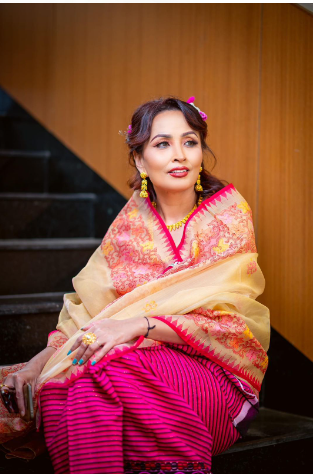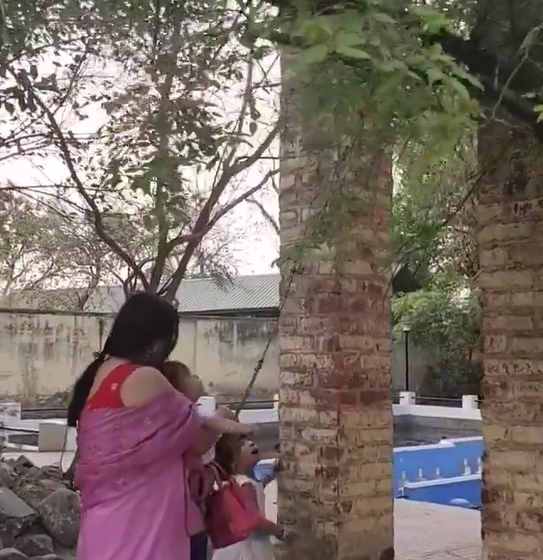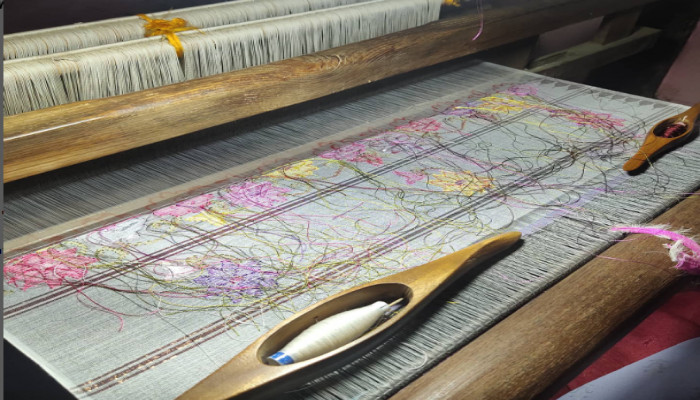Wrapped in a Dream: Exquisite Handwoven Textiles from Manipur
- In Economics
- 11:09 AM, May 06, 2023
- Kaninika Mishra
The little house stands packed between other houses in the narrow street. Someone opens the gate. Inside in one of the rooms, under a naked electric bulb, is the loom. The warp and weft stretch out on the beam, half cloth, half thread, punctuated by filaments of pink and green silken threads. A group of four men sit on empty sacks at the far end of the room. They play cards. Rain beats on the tin roof.
I am at a weaver’s house in Imphal, Manipur. Ibemhal Nameirakpam, a businesswoman based in the city is with me. Ibemhal’s clothing store, Seasons, is a short drive away. Ibemhal stocks traditional Manipuri wear: the sarong, phanek and the shawl like dupatta, phee, made on order by women around the town. The phanek is always in thick cotton, plain or striped. It has a temple design on the border. The upper garment, the phee, is what we see stretched on the loom now. The threads will eventually come together to form a diaphanous fabric, covered in colourful motifs from the creepers, cherry blossoms and the Sangai deer.
Art, after all, takes its cue from nature and Manipur with its large valleys, beautiful hillsides and serene lakes inspires its textiles. In contrast to Nagaland’s sharp mountains, the hills here are gentler, with cherry blossoms covering the slopes. Driving from Nagaland’s Kohima, I find the hills end suddenly. An enormous valley begins. The rectangular strip of the flat earth, with the capital city Imphal at its centre runs north to south. Its towns, paddy fields and wetlands, encompass a total of 1,787 square km. The valley is home to the Meitei people. The surrounding hills are where the Naga and Kuki tribes live.
The Meiteis practice Vaishnava Hinduism, specifically Gaudiya Vasihnavaism, a religious movement established by the Hindu saint Chaitanya Mahaprabhu in the 15th century. While the Manipur valley had been in contact with Hinduism through cultural exchange with Bengal and Assam over several centuries it was only in the 18th century the Meities formally adopted Vaishnavism after the king was initiated into the sect by Gaudiya saints. The Meiteis have, however, never stopped worshipping the traditional deities and the two faiths overlap in many ways. One such colourful intersection is the festival of Yaosang.
I arrive in Imphal on the first day of Yaosang. The entire city seems to have taken the day off, shutters pulled down along shops lined along the main avenue. Celebrated at the same time as Holi for five days in spring, the festival has many unique and familiar traditions. The Yaosang Mei Thaba, or Burning of the Straw Hut similar to the Holika Dahan we know in the North. Later in the evening, it is easy to spot groups of children, dressed in traditional wear, with small bags walking by, knocking every house for monetary donations, reminding of another pagan festivity from another continent—Halloween. I am a little disappointed that the exciting Thabal Chongba (Dancing in the Moonlight) where couples dance in circles has been cancelled owing to the pandemic.
Despite the festival, Ibemhal Nameirakpam, a woman entrepreneur, engaged in Manipuri handlooms is gracious enough to meet me at her showroom. Located on the main avenue going to the airport, her store Seasons stocks a variety of Manipur handlooms. Ibemhal is dressed traditionally. She wears a grey sarong, a casual white T-shirt, and thin grey phee with a red border gracefully draped around her shoulders.
We sit on the low bed in the middle of the store. The shelves around us are stacked with phaneks and phees in different shades, categorised according to quality and colour. Ibemhal picks and spreads out some of her best and most expensive phaneks and phees for me to see.
Ibemhal was a distributor for a cement company before she began her store. She says that she found her previous employment hectic. She has also been in the tyres business. ‘I have done “men’s work”,’ she says with a little laugh. It is difficult to imagine her in a large warehouse among bags of cement. Ibemhal wanted to do something. Textiles appealed to her. She began to contact weavers in and around Imphal and placed orders. Ibemhal makes her work sound simple and straightforward. Like many shops of Manipuri traditional wear in the city, Seasons caters mainly to the local Meitei woman who wears phanek and phee not just for ceremonial occasions and weddings but also as everyday attire.

Unlike Nagaland, where Naga textiles have been reimagined as soft furnishings, Manipur handloom continues to find a big market in its original form. ‘We are more traditional compared to Nagaland,’ explains Ibemhal. The influence of Western missionaries has been limited in the Imphal valley and hence the beautiful Meitei textile endures. Both the sarongs are made with thick cotton with either stripes running through the length or conical temple patterns woven along the borders.
The exquisitely delicate upper cloth, the Phee, is so fine that it used to be worn mainly by royalty. The fabric has been registered for protection under the Geographical indication as Wangkhei Phee and Moirang Phee which are all woven by women of Manipur in the districts of Wanghei and Moirang. It is made with very fine white cotton yarn with a closely woven texture. The interlacing of cotton weft and warp is woven by women, in series and widely spaced from each other, which makes the fabric translucent. The handwoven see-through fabric is airy and wispy, making it feel luxurious.
The holiday season means more buyers for traditional wear. Seeing the shutters up a few shoppers walk in and Ibemhal gets some unexpected business. While Ibemhal’s business is built on the local demand for Manipur handloom fabrics, there are others who serve tourists visiting the town.
One such shop is Rani Devi’s. 'Rani Handloom Industries' was established in 1960 by the late Chungkham Rani Devi, one of the most famous weavers of Manipur. She introduced new patterns and motifs to the woven phee (shawls/dupattas). The quality of her weaving and the fresh designs brought her a lot of popularity and her products came to be known as 'Raniphee'.
Chungkham Rani was born in a family of weavers. She learnt weaving as a child, but she set up her business only later when her husband died, and she returned to her maternal home. In an old interview she had said, 'I saw all those beautiful women flowers, birds and different designs on cloth manufactured outside the state and I was so inspired. I thought how beautiful our own Phee would be if I could weave designs like those into them’.
Rani experimented with silk threads instead of cotton along with creating new patterns. It is said that one of the first designs Chungkham Rani wove on the Phee was a pair of swans, a lotus and two lotus leaves. Her talent and effort brought business as well as accolades. She played a key role in establishing the handloom textiles from Manipur as a collectible heirloom much like the handmade Kanjeevaram sarees of south India or the Banarasi sarees from Varanasi. She received certificates of honour for her outstanding contribution to handicrafts from both the state as well as the national government. The fact that Raniphee has become a generic name for the handwoven Phee made in Manipur is a testament to her skill and imagination.
Her legacy continues and her family runs the retail outlet she set up. They work towards passing down her art to the new generation through a 'Learning cum Earning Weaving Scheme'. To keep alive the tradition of 'Raniphee', their factory provides intensive training to its workers. The workers weave cloth in their homes and sell it to the Rani Handlooms. They make Raniphee, Phanek, Silk sarees, Salwar kameez, bed cover sets etc. The Phee, however, remains their most exquisite product.

I spot one such beautiful Phee resting daintily on the shoulders of a young woman as she rings the bell at Govindjee temple. The temple built in 1846 by the monarchs of Manipur is holding a special Kirtan for Yaosang. I see foreheads adorned with a Vaishnav Tilak. The men are in dhotis and it is heartening to see all the women in Phanek and Phees of different colours.
All the images are provided by the author.
Disclaimer: The opinions expressed within this article are the personal opinions of the author. MyIndMakers is not responsible for the accuracy, completeness, suitability, or validity of any information on this article. All information is provided on an as-is basis. The information, facts or opinions appearing in the article do not reflect the views of MyindMakers and it does not assume any responsibility or liability for the same.







Comments